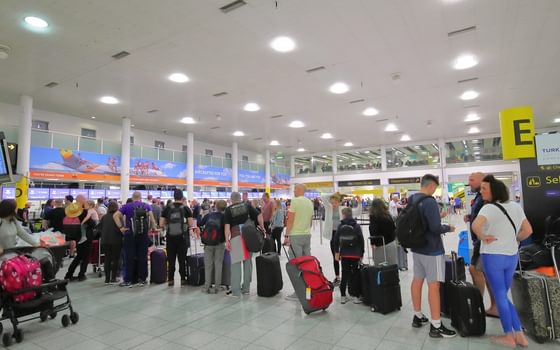The Jet Zero strategy is an abdication of responsibility to the planet and future generations
Drawing a downward slanting line on a piece of paper and crossing your fingers is not a ‘strategy’
28 July 2022
This article was originally published on BusinessGreen
When is a strategy not a strategy? We found out the answer earlier this week when the High Court upheld an NGO challenge to the government’s Net Zero Strategy. The plan was supposed to set the path to cutting our carbon emissions to net zero by 2050. But, as a brutal heatwave buckled railway lines and caused fires in London, the judge has sent the government back to have another go, citing the strategy’s failure to set out the policies needed to hit our emissions reduction targets. But if the Net Zero Strategy was flawed, yesterday’s ‘Jet Zero’ strategy for the future of the aviation sector is something worse.
Despite temperatures reaching levels never before seen in the UK, the day started as many others have in recent times, with a government press release laden with misinformation. The headline claim was: “2019 set to be remembered as the peak year for aviation emissions”. But the Jet Zero strategy doesn’t actually say this. It sets a target for carbon (CO2) emissions to peak in 2019, but ignores non-carbon gases like water vapour or aerosols, even though in their own words, their “net warming rate is likely to be around three times that of CO2”. These non-carbon gases really matter when you consider that underpinning the strategy is a forecast that the UK will see 720,000 (+33%) more aircraft journeys a year by 2050.
A more accurate headline might have been: ‘government sanctions unlimited air travel growth and 2.5bn tonnes of emissions’. Between 2023 and 2050 the government forecast that the aviation sector will pump out some 837 million tonnes of CO2. When we apply the final step, unforgivably missed by government, and take non-CO2 emissions into account, this rises to a best estimate of 2.5 billion tonnes of CO2e equivalent emissions. In 2035, when the overall economy’s emissions are legally supposed to be down 78%, aviation emissions will be up 50%. In 2050, when the wider economy should be emitting net zero emissions, aviation will be pumping out the same volume of emissions as it did in 1990. To fit this square peg in a round climate hole, the government plays its ‘get out of jail free’ card: “this scenario results in 19.3 MtCO2e [sic] of residual emissions in 2050 to be offset or removed”.
“A more accurate headline might have been:‘government sanctions unlimited air travel growth and 2.5bn tonnes of emissions’.”
So there you have it. Jet Zero pulls of the impressive feat of containing 62 ‘policy commitments’ yet none which will actually ensure the decarbonisation of the sector. Instead, government gambles on being able to capture and store 20 – 30 million tonnes of carbon per year by 2030. As it stands, the world’s largest carbon capture plant has been having major trouble capturing just 0.02% of this amount. To believe that we’ll scale this up by a factor of 6,250 in just eight years seems like an incredibly risky, expensive, and unnecessary gamble with our safety and our futures. Not only that, but if we are serious about preventing the deadly heatwaves, summer wildfires or flooded homes which will result from climate breakdown, government will also need to do something about the non-CO2 gases.
At its core, the Jet Zero strategy represents an abdication of responsibility. The events of the past few days show us that we need serious action to eliminate dangerous fossil fuels as soon as possible. The government’s plans are paltry. The much trumpeted ‘sustainable aviation fuel’ (SAF) mandate — that 10% of planes’ fuel mix should be sustainable by 2030 — is anything but. The latest research suggests that SAFs currently have an environmental impact almost as bad as traditional fossil fuels. Even in the government’s optimistic modelling the modest shift to SAF has minimal impact: the government still expects the aviation sector to be producing more carbon emissions in 2030 than it did in 2016.
Missing from Jet Zero is a simple, and relatively painless control on emissions. All government need do is make any further expansion of air travel conditional on tangible emissions reductions delivered. This control should be set against a sector emissions trajectory which puts safety first, applying the ‘precautionary principle’ mandated in the recent Environmental Principles Policy Statement. This means tightening emissions faster in the short-term when the availability of techno-solutions is lowest and risk is highest. With the industry publicly projecting great confidence in its ability to scale-up emission cutting technologies, they would presumably be relaxed about government holding them to account in this way.
There are already policies which would cut emissions in the next few years — and those policies are very popular with the public. A significant majority back a frequent flyer levy, which charges higher ticket prices for those who fly often. The public also support the need to limit airport expansion to reduce aviation’s impact on the climate. Given that business air travel was already stagnant before the pandemic forced us to get comfortable with video calls, there is clearly limited business demand for expansion of air travel outside of the aviation industry itself.
Drawing a downward slanting line on a piece of paper and crossing your fingers is not a ‘strategy’. The heatwave damage we’ve seen this week shows us what it really is, a deeply dangerous and irresponsible act of unnecessary self-harm.
Image: Pexels
Campaigns Stop airport expansions
Topics Transport Climate change






